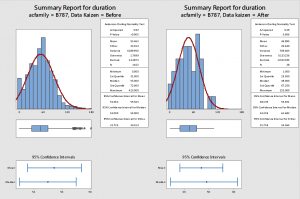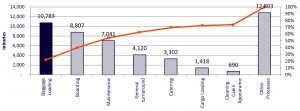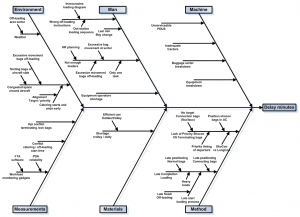Reducing baggage handling delays using Lean Six Sigma
Lean Six Sigma enables airlines to be in control of their operational processes.
At Kenya Airways the Lean Six Sigma team reduces waste in the baggage handling process and gives insight in KPIs to reduce process variation, ultimately leading to lower costs and increased revenues.


“The Lean Six Sigma Continuous Improvement Cycle enables airlines to control the right inputs to achieve a consistent baggage handling process”
Situation
Method
Control



Connecting baggage is the biggest contributor (23%) to flight delays related to the aircraft turnaround process. It severely impacts the airlines’ on-time performance. Baggage delays are an inconvenience to airline guests, negatively affect brand value and result in lower aircraft utilization. Furthermore, they require significant repair actions and passengers compensation.
The baggage handling process is a complex operational process with multiple stakeholders. The project targets process waste, analyzes root causes for variation and sets up a control plan to continuously monitor process input and output performance.
The final goal of the project is to align the most important airline's KPIs, control these by reducing variation in the process and improving the average process lead time. Being in control of the operational process enables the airline to consistently achieve its targets.
Presented at the 56th annual AGIFORS airline operations research symposium in Santiago de Chile.
Abstract: "This case study is a practical implementation of the Lean
Six Sigma (LSS) method to improve on-time performance and specifically, reduce connecting baggage related delays at Kenya Airways. The project contributes significantly to the financial bottom and top lines as flight delays impact (1) direct ground handling operating costs, (2) passenger compensation costs and (3) so-called “soft” costs or lost revenue opportunities due to brand damage. Using he Define – Measure – Analyze – Improve and Control (DMAIC) continuous improvement cycle the connecting baggage handling was identified as the main contributor to aircraft turnaround delays. The required data was then collected, tested and used to determine the process baseline performance. In a deep dive analysis, the root causes for process variation were identified, resulting in three main improvement areas: (1) out-station loading sequence determination, (2) baggage off-loading and (3) baggage loading. Three pilot cases studies are currently being executed to test solutions to (1) address the out-station loading sequence determination, (2) redesign the narrow body turnaround process to eliminate waste and (3) improve team work between baggage handling and ramp teams by aligning key performance indicators. Using the LSS improvement approach, Kenya-Airways has redesigned its baggage handling process to be better in line with it business model, serving a majority of connecting passengers. Delay costs analysis indicate that continuously improving the baggage handling process can save up to 7.5% of Kenya-Airways’ delay-related costs.
